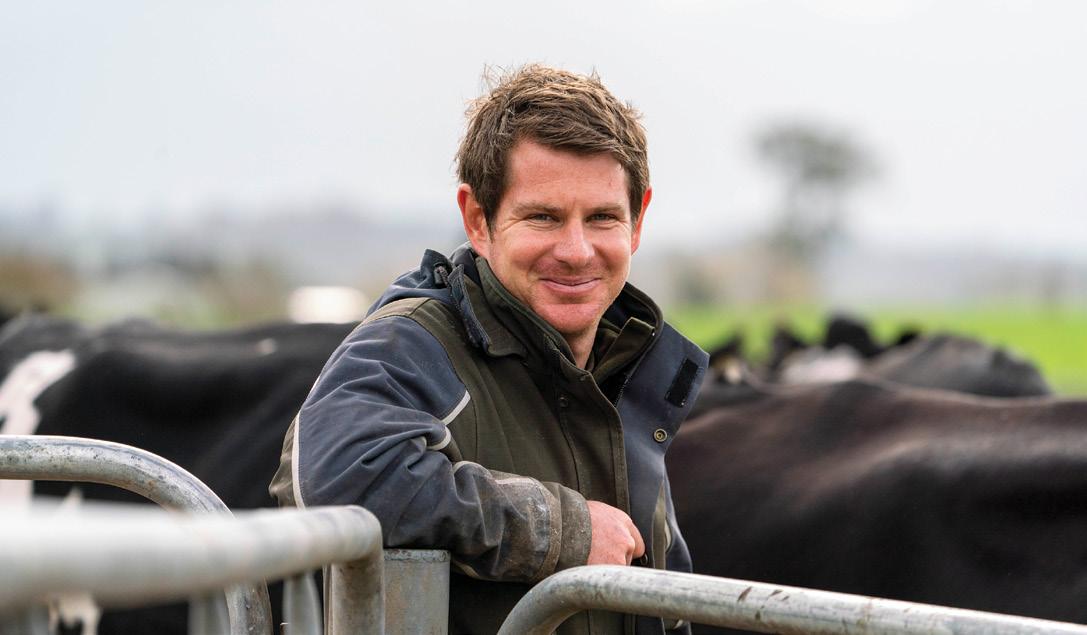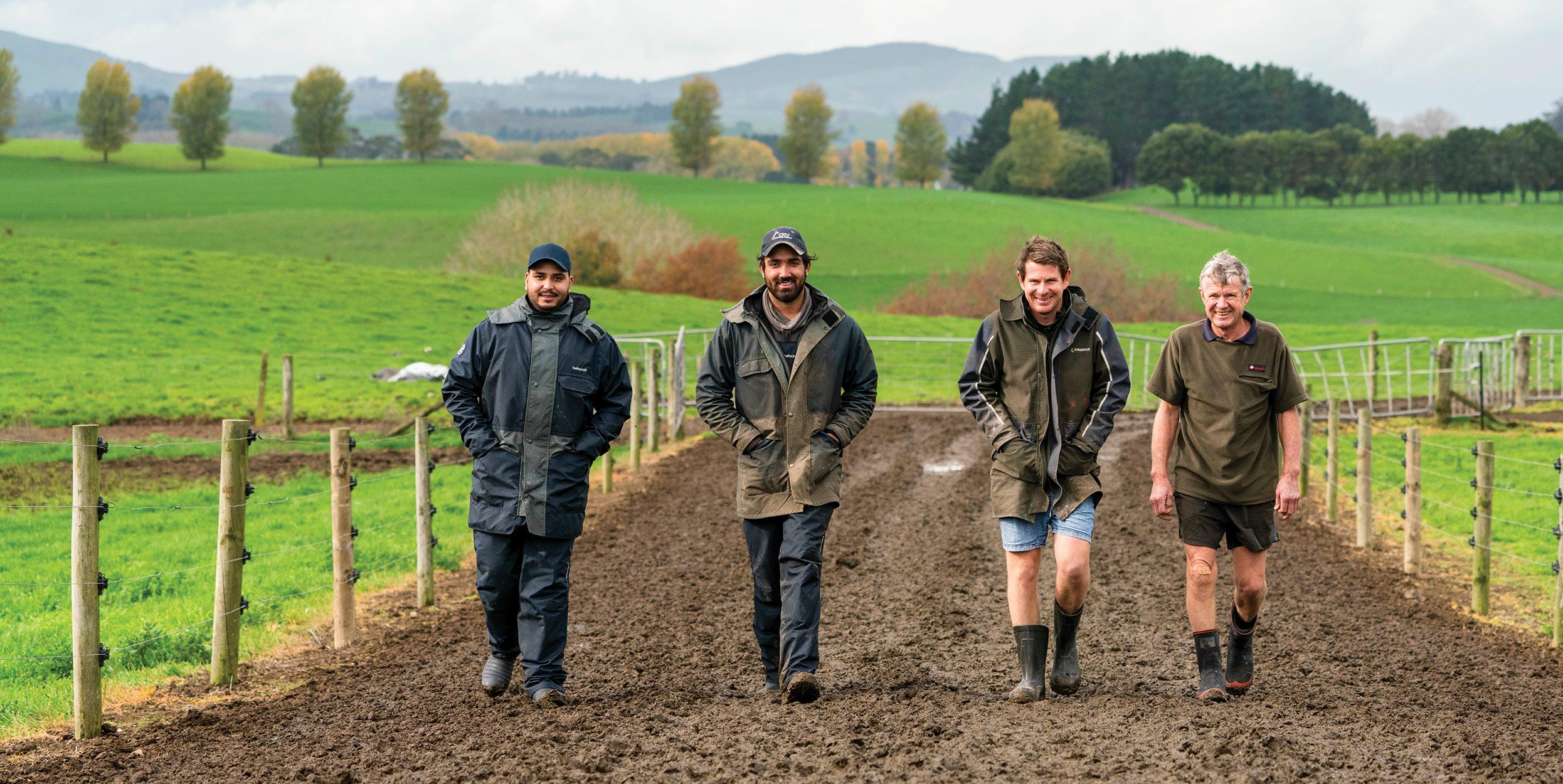
9 minute read
Shining through the drought
SYSTEMS ONFARM
Dave Swney - there is always things to improve on in your operation.
A lot of little tweaks have helped the Waikato Swney family reduce lameness and run an improved operation for both cows and staff. Sheryl Haitana reports. Photos by Emma McCarthy.
After a harsh 2019/20 drought, the Swney cows were still looking “magnificent” heading into winter, nutritionist Sue Macky told me on a recent phone call.
That’s a pretty good compliment coming from one of New Zealand’s most highly regarded dairy cow nutritionist specialists, after a drought that lasted through autumn this year, so I thought it was worth a farm visit.
The Swney farm is five minutes south of Te Awamutu. Owned by Phil and Deb Swney, their son Dave is now contract milking for them.
Dave is a former DairyNZ consulting officer, but he returned to farming seven years ago. Recently Dave has also taken on an operation manager’s role overseeing three other dairy operations in the Waikato region.
“Working for DairyNZ was a great job, I learnt a lot, but it was always the plan to give farming a crack.”
Phil and Deb have owned the farm for 30 years, having sharemilked on the original milking platform almost 40 years ago.
They bought neighbouring blocks over the years and the now 124-hectare effective milking platform is rolling with ash soils. They lease 28ha across the road off local maize contractor John Austin where they winter graze annual grass.
“That lease is key to our system, 280 cows go there for five weeks. It gives us the ability to have that buffer up our sleeves,” Dave says.
“One of the greatest lessons I’ve learnt from dad is how important it is to keep good relationships and a good reputation in the district.”
Phil started farming a high-input system on just 40ha when he bought the farm 30 years ago. He had attended a large herds conference and heard about overseas farms producing the same production as the cow’s body weight.
“I thought we could do half way between what they were doing overseas and what we were doing here.”
They still run a DairyNZ System 5 operation, feeding predominantly maize silage, palm kernel and straw, using their 280-cow feed pad, averaging about 500kg MS/cow.
As the farm intensified over the last few years they started having major lameness problems.
“I was looking at 20% of the herd regularly, I’m really particular and try to be proactive. If she had a slight limp I would look at her. It was doing my head in. We were spending a lot of money.
“It was getting frustrating, we knew we didn’t follow cows hard in the races or push cows too hard in the yard and the races were always well maintained.”
The family called in Sue to get a fresh perspective on their system to try and pinpoint the issue.
She looked at the cows and their diet over the season. She highlighted a few key

Top: The Swnes farm is 5 minutes south of Te Awamutu. Above left: Tweaking the cows’ diet has helped reduce lameness. Above right: Dave Swney, a former DairyNZ consulting officer, returned to the farm seven years ago.


FARM FACTS
• Owners: Phil and Deb Swney • Contract milker: Dave Swney • Location: Te Awamutu • Area: 124ha effective, 28ha lease block over winter • Farm dairy: 40-aside herringbone,
ACRs, automatic drafting and teat sprayer, Protrack • Cows: 440 peak crossbreds • BW/PW: BW 122/51 PW 174/57 • Target production: 220,000kg MS (1800kg MS/ha, 495kg MS/cow) • Pasture and Crop harvested: 14t
DM/ha • Crop: 5ha maize on milking platform; 13ha chicory • Supplement: 2.2-2.5t/cow/year (Palm kernel, maize silage, Procow 30, straw, soy) • Effluent irrigation: 30ha (solids spread on maize block)
issues with their diet, in particular over the winter period. They swapped maize out for straw. The straw is fed along with the annual grass during winter and has worked very well.
Other changes include putting rubber matting down at the front of the yard and in the bails and for the last four seasons they have milked the heifers and light cows once a day (OAD) all season.
“We’ve managed to produce the same amount of milk,” Dave says.
“We might lose a little production in that first one or two lactations by milking OAD, but it’s made up with less wastage and we get more cows back in calf.”
They’ve had multiple improvements in the herd, from reduced lameness to improved reproduction results.
“The hardest thing is to pinpoint what has been the main improvement, it’s a combo of things,” Dave says.
Bringing Sue in as a consultant has challenged their entire operation.
“It’s pretty hard mentally to deal with lameness, so we got Sue onboard for that reason, but we’ve picked up a lot more along the way,” Phil says.
“Sue has taught us a lot about cow behavior and understanding what the cows need.”
Even after farming for 40 years, it’s important to constantly challenge yourself because you can always learn, he says.
A lot of the minor tweaks they have made has not only been good for the cows, but also good for staff, Dave says.
For example, feeding straw a few days in advance is easier than feeding out maize during winter, so it’s made the operation more efficient and labour friendly.
Milking the younger and lighter cows on OAD year round, means less time in the farm dairy.
The OAD herd is sent on the furthest walks, while the ‘work horses’ are kept closer to the shed and fed twice a day on the pad.
Both herds are on a bat-latch with nobody following them so they can take their time.
At calving, every cow is kept on OAD for
the first two weeks of their lactation.
“It really helps us with our workload, I don’t think we’ve lost any production and there has been no impact on mastitis.”
In the summer months they do their afternoon milkings at 1pm, giving the cows more access to shade and putting them under the sprinklers. This gives the cows an opportunity to cool down before their body temperatures get too hot later in the day.
Sue pointed out that the coolest place on the farm during the hottest part of the day is the cowshed.
They put in sprinklers and misters in the farm dairy and the cows now fight to get under them and their tails are not moving because the misters stop the flies coming in.
This year they held production through the hottest of days rather than dropping.
They also have a shade paddock where cows can go to and from the feed pad.
The farm has switched to having no bulls on the property and using Artificial Insemination (AI) for the full 10-week mating.
Their reproduction figures have improved over the last few years, their 6-week in-calf rate has gone up to 74% after slumping to 65%, and their empty rate has dropped from 17% to 9-11%.
Phil has been nominating for 30 years, having worked for Ambreed as an AI technician for 10 years. He still does the farm’s AI.
“It’s a big passion of dads, he’s bred a pretty amazing herd.”
It was a big leap to go without bulls, but it also coincided with Mycoplasma bovis so it worked well. The bottom 5-10% of the

FWE (per kg MS)
Operating exp (per kg MS)
EFS (per hectare)
18/19
$4.47
$5.26
$2,850
17/18
$3.92
$4.64
$4,110
16/17
$3.97
$4.70
$3,513
Left: Happy cows = happy staff. From left, Udayveer Singh, Manny Singh, Dave and Phil Swney. Keeping staff happy means they stay around, Dave says. “Manny has been with us for five years, we have given him progression opportunities and he’s grown to be an important part of our operation.”
herd are mated to Angus and Hereford.
“It makes mating a long grind for staff, but you weigh that workload up with not having to have bulls onfarm wrecking fences and the health and safety factor. We’re pretty lucky we have a good team.”
They have decreased the number of CIDRs to about 15 and track pre-mating heats using tail paint and scratchies.
For the last four seasons they’ve opted to keep their calves at home, and just send their yearlings out grazing down to Piopio in the King Country.
They’ve reduced cow numbers from 450-500 down to 440 to accommodate the calves, but it works well, Phil says.
The calves graze 4ha of chicory and also get a bit of palm kernel and straw.
“We really enjoy having them home. The calves are kept in one mob and have about a 25-day round on the chicory.
“It’s the worst drought I can probably remember this year, lasting over summer and autumn. The chicory worked well.”
They also grew another 9ha of chicory for the cows this summer. They’ve switched from turnips because they have a use-by date, and they are finding the chicory is growing well, even in the toughest of summers.
“Summer is our biggest risk period. We tried chicory this year, we really like it. We want to be able to grow as much feed as we can ourselves,” Dave says.
“We are pretty consistent now with pasture and crop harvested, feed cost is our focus.”
Pasture is still their biggest focus, so they do regular farm walks through the season.
“The relationship between feed costs and payout is always our biggest challenge.”
They fix their palm kernel and maize contracts every year to keep control over their costs.
They have been feeding up to a tonne of palm kernel/cow/year but that’s getting hard to keep up with the new FEI.
“Managing regulation is a big challenge. It makes it harder to do what we have in the past. We are looking at other supplement but also reducing the intensity of the system.”
Phil and Deb have always used DairyBase to benchmark themselves against and they aim to be in the top 20% of farms, Dave says.
“Some years we do okay, some years we slip. That’s where we want to be, in the top 20% for EFS.”
They still have more to work to do; focusing on cost control, chipping away on putting more water troughs in paddocks and planting more trees for shade.
The future is easier to manage knowing they have Dave home on the farm, Phil says.
“We are really lucky to have Dave here, he puts his heart and soul into it.”










